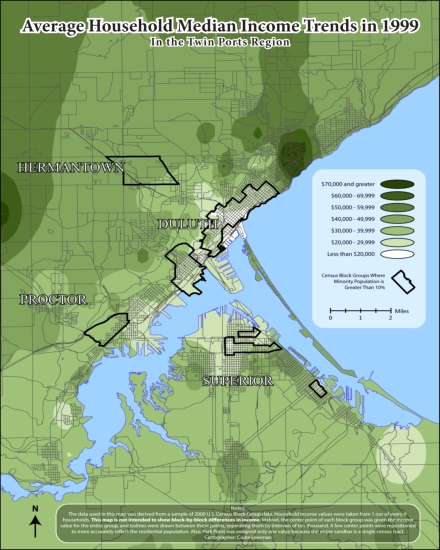Mapping Inequality in Duluth
Hey everyone! This is a map I made in college a couple years back that shows patterns of income and racial segregation in Duluth. I have been going through all the files on my computer and figured the fine folks at PDD would appreciate this one. If you want to see more, I have started a photoblog: http://codiemaps.wordpress.com. I will try to post something new every couple of weeks. (Spoiler: My next map is a pseudosociological breakdown of Minnesota’s core regions.)
Recommended Links:
Leave a Comment
Only registered members can post a comment , Login / Register Here















52 Comments
Claire
about 13 years agoRob
about 13 years agoIron Oregon
about 13 years agoconrad
about 13 years agojohn
about 13 years agoadam
about 13 years agoCodie
about 13 years agoClaire
about 13 years agojake
about 13 years agoPaul Lundgren
about 13 years agoClaire
about 13 years agoPaul Lundgren
about 13 years agoIron Oregon
about 13 years agoIron Oregon
about 13 years agoBarrett Chase
about 13 years agoCodie
about 13 years agojessige
about 13 years agoCodie
about 13 years agoadam
about 13 years agoLes F
about 13 years agowildreed
about 13 years agodbrewing
about 13 years agoShane
about 13 years agoGary
about 13 years agoTom
about 13 years agoLojasmo
about 13 years agoRamos
about 13 years agoRamos
about 13 years agoChris
about 13 years agoThe Big E
about 13 years agoBarrett Chase
about 13 years agoRamos
about 13 years agoBarrett Chase
about 13 years agoDaVe
about 13 years agoRamos
about 13 years agoBarrett Chase
about 13 years agoRamos
about 13 years agoBarrett Chase
about 13 years agoBarrett Chase
about 13 years agoDavid Beard
about 13 years agoDavid Beard
about 13 years agoMashtato
about 13 years agoChris
about 13 years agopH
about 13 years agoCodie
about 13 years agoCodie
about 13 years agoRamos
about 13 years agonorthlandiguana
about 13 years agoCodie
about 13 years agoMetalist
about 13 years agoSonya
about 13 years agoMashtato
about 13 years ago